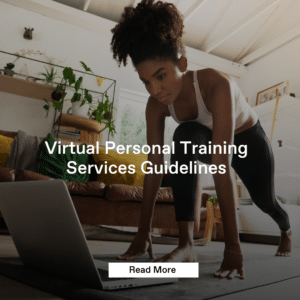Exercise Guidelines » Virtual Personal Training Services Guidelines
Virtual Personal Training Services Guidelines
Safety Guidelines
There has been substantial growth in the delivery of virtual (online) training in the Australian Health and Fitness Industry due to the continual evolution in accessibility, connectivity, and the restrictions on how and when people can exercise.
There are many benefits to delivering exercise services virtually, including:
- The ability to reach a wider range of clients such as those in rural and remote areas Providing clients with a new, convenient way to access services
- Adding a new income stream outside of the traditional face to face training
- Enabling clients to remain active and connected despite their working or personal commitments.
Running virtual personal training services is different to running a session where clients are physically present. There are new challenges and risks that need to be appropriately managed. Clients must always be provided with the same duty of care as they would if the session were face-to-face. This document outlines the best practice guidelines for personal trainers delivering virtual exercise services. These recommendations should be adhered to in conjunction with the Code of Ethical Conduct and Scope of Practice for AUSactive Registered Exercise Professionals.
What’s in the Guideline?
- Qualifications and Registration Categories
- Participant Safety
- Program Development
- Referral
- Insurance
- Informed Consent
- Recording of Sessions
Acknowledgement
AUSactive would like to thank members of the Health and Fitness Industry Standards Council for their contribution to the development of these guidelines.
Receive our Guidelines
Complete your details below and we will send you a link to your inbox to download our Virtual Personal Training Services Guidelines.



